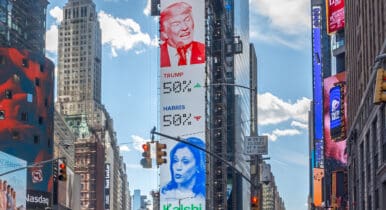How One Designer Has Adopted a Template Model to Unleash Her Party’s Creativity

While working towards her degree at Syracuse University, Laura Beth Pelner had a dream of being an advertising executive. But after graduating in 2007, Pelner wasn’t fulfilled by creative work on corporate accounts.
After about 10 years of doing comms work for different nonprofits and a stint in the Peace Corps, the New Jersey native launched a career in politics — first working for Indivisible and later the 2020 Bernie Sanders presidential campaign. Now, Pelner serves as the creative director of the Working Families Party, where she helped launch a rebrand in 2020.
C&E: What does a typical day look like for you?
Pelner: None of my days are pretty typical because I’m building the creative team at WFP. Mostly, I’m trying to create a design system that really works across the party because we’re in many different places in different states and have different projects and needs.
I try to make sure that, in terms of design and creative, the staff has the tools and the resources that they need in order to create content on their own. Anything from social media to video to on-the-ground canvassing materials, I’ve created a template system that they use in an application called Figma. I also create templates in Canva. And so really honing the system every day and getting feedback to see how those resources help people. I’m also trying to build out our video program.
C&E: Do you want supporters and staff to take your designs and make them their own, or follow the party’s brand guidelines?
Pelner: It’s a capacity issue. There’s no way that a lone-wolf designer or creative can take on the requests for an entire organization. If people wanna be creative, I want to empower them to do so. I really want to democratize design as much as possible and creative as much as possible and really be hands off. When I see staff posting on their individual social media accounts — anywhere from Instagram to Mobilize — I try to hold their hands as much as possible, but not stunt their creativity.
And I create many ways to do that. Not only the template system, but I also have a creative channel in our Slack so that people can share their creative ideas as well as build a community. I really try to foster that creativity and, you know, not to nitpick because a lot of designers can do that.
C&E: Do you feel like there’s a defined progressive aesthetic at this point?
Pelner: I think that in the digital age, we need to try and push the envelope a little bit. Especially being a queer, Hispanic designer, I try to pull from both historic and current trends in different communities — because we can’t just keep on doing the same old direct mailer style. It doesn’t stand out in any way or doesn’t have any character to it.
So I actually try to look outside of nonprofits, political organizations and the progressive space. I can adapt what I see trending in the design world, which is like a whole mixture of people from different industries. I tried to mesh that into what we could be doing for political design and doing a lot of trial and error, doing a lot of testing too.
C&E: What about TikTok, are you using that platform?
Pelner: TikTok is something that we have not really cracked. We’ve done a few tests with our social media manager just kind of doing it on their own page and then posting it to our national channels and that seem to be working well.
C&E: Do you have an influencer outreach strategy?
Pelner: We’ve tested it — working with content creators and artists and doing collaborations. And we’ve been trying to figure out a collaboration where that makes sense, but I have to be honest: it doesn’t seem to do well. I think that these influencers have a ton of followers, but that they aren’t particularly political.
So we have not cracked the code on how to work with influencers. On the Bernie campaign, it was a little bit easier because Bernie was such a celebrity in so many different demographics, and had some really big celebrities that were really useful to get for audiences that we never would’ve reached before.



